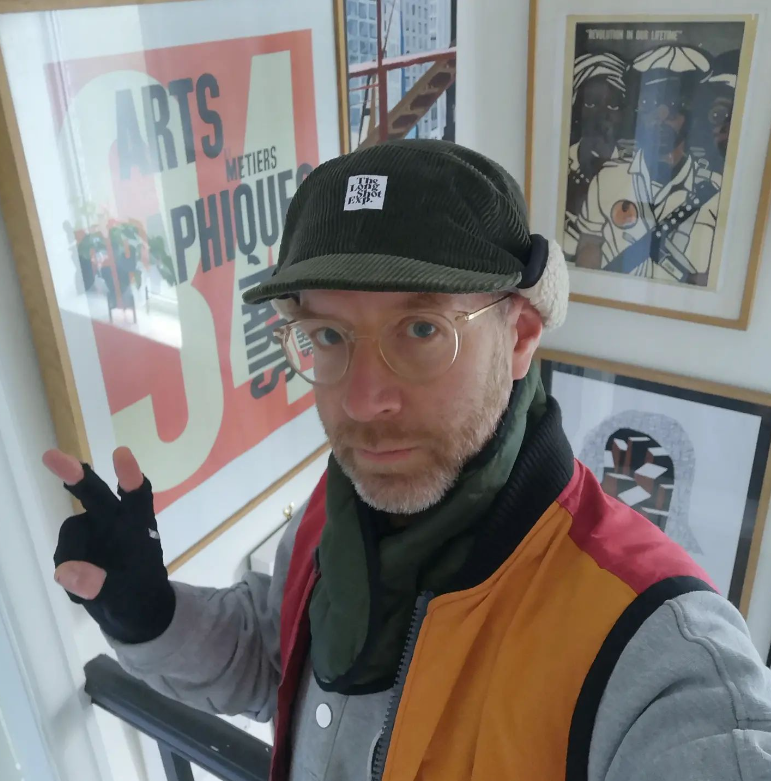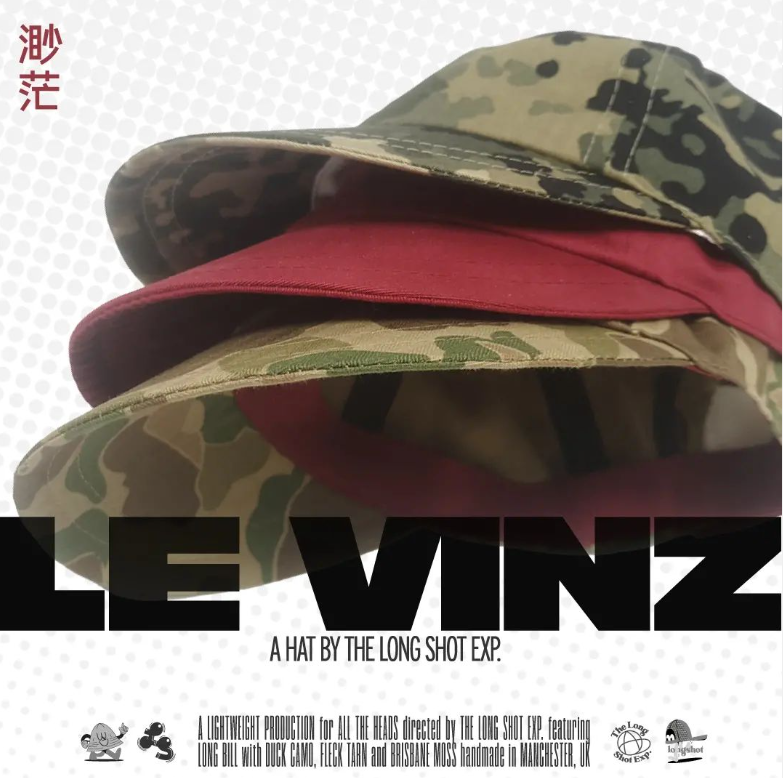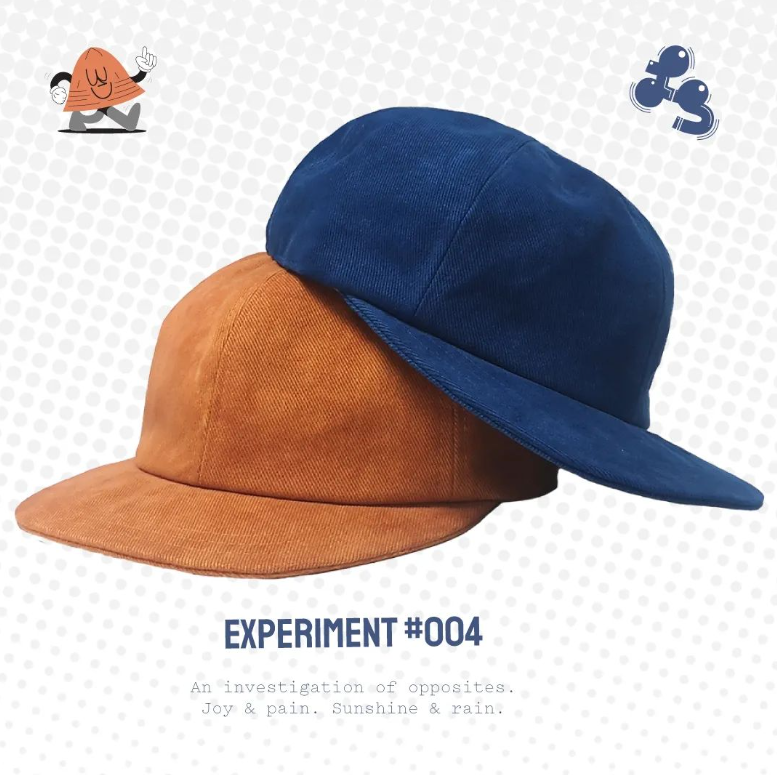Hats off to this Manchester-based milliner
Bionic spoke to Mike Holmes, who has been running his own hat company for nine years now. We heard how he built his brand from scratch and discovered why he thinks it’s so important to go with the flow in the business world.
“I make hats from my workshop slash garden shed,” Mike laughs when we ask him to give us the deets on his business ‘The Longshot Experiment’.
“When I started, I wasn’t looking to start a business necessarilyy,” he says, casting his mind back to the start of his small business journey, “I just needed a creative outlet. I was used to working in graphic design but after the birth of our second child, I stopped working in the studio and stayed at home with the kids. I just needed something to keep my creativity going, to be able to play around with graphics and creative branding.” He explains.
So how did the business aspect of a much-loved hobby develop? Mike says it was very natural and that’s what's so special about it.
“I learnt manufacturing skills in college, but creating a business was always just a fantasy really,” he muses, “one day I decided to make a hat. It seemed an accessible item to start with. I just used small pieces of fabric and it didn’t take long to make.”
“It was a business idea in a way,” he continues, “but without the pressure of actually making a business. I built a brand, because I like doing that, and set up an Instagram account because it was free. From there I could work on visual language and photograph products to get them out there.”
He goes on, “But it was probably about two years before the word professional even came into my vocabulary. I had no pressure, so it gave me room to make mistakes.”
Savvy with social
Social media is often an invaluable tool in the small businesses owner’s arsenal. Mainly due to the reasons Mike mentioned himself; it’s a free way of advertising and getting your products out there, and it’s an easy way to reach more potential customers.

Instagram in particular has been useful for showcasing the impressive array of quirky hats. But how else has Mike built his brand over the last nine years?
“Our Insta is a business account because then I can tag products. That’s a really easy way for customers to get to our site.” Mike tells us, before recalling his roots. “I initially started on a free ecommerce site, it had nice, clean modern-looking templates and was really easy to set up and maintain whilst bringing up two kids. I slowly built that up,” he tells us, “then, I found myself with a bit more time when the kids went to nursery, so I worked on it and gradually sold more hats.”
And what about other social platforms like X, Facebook and TikTok? Does Mike find them as valuable as Instagram?
“I used Twitter (X) briefly, but it didn’t work. But I do think social media is important. It’s immediate.” He says.
Mike also mentioned that how you portray your brand is an extension of you as a person, and making an effort to appear more ‘human’ can help you relate to customers.
“I mean, until 2020 any messages I sent from our social media accounts would be presented as the brand and would be signed as ‘we’ or ‘the team’ rather than ‘Mike,'” he says.
Mike says although he initially enjoyed this anonymous aspect, he decided to make his customer interactions more personal as the business grew in popularity.
“In a way, I was hiding behind the brand at the start. I could put products out there that I might not have been confident enough about if I was using my own name. It wasn’t until 2020 I thought to upload a video of myself and just talk to my followers. But the response was really good. It was like me saying to my customer base ‘I’m just like you’, ‘we share lots of common interests and likes.’” Mike grins.
Sharing the love
Mike says he’s also dabbled in email marketing. He’s seen great open rates from sharing genuinely interesting things with his subscribers rather than just trying to push hat sales.
“With the newsletter, I was inspired by Hired Denim, which is a brand I love, I thought hard about the newsletters I subscribe to and most of the ones I actually read were from brands that weren’t directing me to their site. They just had lots of interesting stuff in there.”
Mike says taking note of Hired Denim’s email campaigns encouraged him to think about what made him loyal to other brands.
“I realised it’s not really about the brand or the products they sell, it’s about shared interests and likes, it’s about what I’m getting from the interaction. I started a concept called ‘look, listen, read and think’ and I built it into my own newsletter.”
So, what’s next for Mike? He’s got lots of big plans and wants to cement these customer relationships.
“The next step I’d like to take is to have monthly guests. It takes away some of my content pressure and it’s also someone else’s view on things," he says, “at the moment, I get a 50% engagement on Mailchimp. The clicks may not be straight to the site, but it keeps people reading the newsletter because they’ve found something interesting. It helps me get to know my community and customer base, and I can share things with them.”
Hats of success
High points aside, Mike’s journey hasn’t been without setbacks. He told us initially he wasn’t making much money but if he’d given up at the first hurdle then he never would have reached the success he’s enjoying now.

“In the first year I sold about five hats,” he chuckles, reminiscing, “and if I’d gone into the business thinking it was going to be a viable income stream, then I would have probably given up there and then.”
“But I never had the pressure for it to be anything other than an outlet, so that meant a couple of years down the line I was able to build and take it more seriously, be a bit more professional,” he adds.
Mike has a impressive background in graphic design and his creative mindset obviously helped when coming up with concepts and designs for the hats, but what does he think is the most important thing about branding? He says going with the flow and keeping it simple is vital.
“I gained experience with a great branding studio in Liverpool, we’d worked on brands and there was a real creative side to it, but there was also a lot of politics,” Mike says, “at the end of the day, every client just wants a logo that looks cool, but I found with these studios you’d have to tie it all in and be like ‘well your brand values are this, this and that, so that’s what this logo represents.’”
Did Mike channel his want for simplicity and effortless swagger when designing his own logo? He nods.
“Our initial logo was hand drawn and I didn’t make any of those brand value decisions at the start. I was trying to channel a punk attitude to branding,” he laughs.
“I mean, a couple of years down the line, it would have been helpful if I’d put some of those values in place earlier, it might have helped me as the business got more serious. But the whole point of the ‘Longshot Experiment’ was to allow me room.”
He goes on, “that’s why I chose that name. It doesn’t sound too specific, it could be a film, it could be a band. The ‘experiment’ part allows me to play about with my designs and brand.”
Does Mike think working in fashion limits his way of working in any way?
“I think working in fashion allows a lot of mobility. I create clothing, and because of the constant turnaround, you know, different seasons and new ideas, you can reinvent yourself. I think brand wise, you have a bit more room to do that in fashion,” he answers.
“But it’s about not being so strict on what we do,” Mike adds, “If I see a new film or hear a new band, or something gets me excited, I want to bring that into what I create.”
The small business with big potential
Mike says that being a small business is an aspect he really enjoys. Although his company has built up traction and now has larger scale clients, he still loves coming up with new ideas and concepts for his loyal customer base.

“I’m a very small-scale maker,” he says, “at the beginning, I would buy a few different pieces of fabric and just use what I had. As I moved on, I wanted to present myself more professionally. So, I started making decisions like ‘I’ll buy two metres of this colour, two metres of that and this is what this season’s products will be made of.’ I slipped into the fashion industry way of working quite quickly.”
He goes on, “the last couple of years, I’ve had a few wholesale customers and small brands asking me to make small batches of hats for them. That’s given me the ability to make thirty, forty or fifty specific hats, but then I’ve still got the opportunity to be really creative when I come back to making my own, I get to play around with other fabrics again and make it fun.”
And he really does have fun with it, he’s inspired by movies, music and even patterns in discarded wood.
“Someone was cutting trees down the other day,” he tells us, “so, we got a load of wood dropped outside, and I just remember thinking the colour was gorgeous. It kind of looked like a cameo effect. So, I decided to create a hat based on that pattern.”
Mike says that his creative process is fluid on purpose and he does his best work when he’s less rigid.
“Guidelines are great, but rules are there to break,” he says sagely, “you’ve got to allow certain areas where you can be looser and evolve.”
So, if he could choose just one thing, what is Mike’s biggest achievement as a small business owner?
“The fact that it’s been nine years now and that’s a long time,” he smiles, before continuing, “that’s my achievement. Sticking with it and trying different things like t-shirts, for example. The fact that I still find my business exciting is great too, because that’s important.”
And what about struggles, how has Mike been coping amidst the cost of living crisis?
“Because of my business size and the fact I still use my home workshop, I’m quite light on overheads. In the winter, I bring out a heater as I have Raynaud Syndrome and obviously I need to work a lot with my hands, so that can be hard.”
“I previously brought a solar powered lamp too so I could work into the evenings. So all my lighting is solar powered,” he adds.
And as a parting gift, if Mike could share one slither of advice with a budding business owner, what would it be?
"If someone is wondering whether or not to start a business, I’d say just do it,” he tells us, “but I’d say be playful, make sure it’s something you’d be interested in beyond making money. You can get normal jobs that do that.”
He carries on thoughtfully, “If you’re running your own business, you need to enjoy it even when it’s not paying you well. You have to stick with it through the storms. You have to like it enough when it’s tough and it’s a slog.”
Check out Mike’s selection of handmade hats on Instagram, Facebook or The Longshot Experiment’s website.
Whatever your business story, at Bionic we can help sort your business essentials including tailored insurance for your online business and we can also help with securing your next business energy contract. Get in touch today for support.




